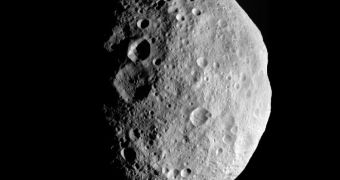After having spent more than a year circling the most massive asteroid in our solar system, the Dawn spacecraft is currently on its way to meet up with the dwarf planet Ceres, in the Inner Asteroid Belt.
The orbiter launched aboard a Delta II rocket on September 27, 2007, from Space Launch Complex 17B at the Cape Canaveral Air Force Station (CCAFS), in Florida. By February 4, 2009, it had reached the Red Planet, where it performed a slingshot maneuver to gain more speed.
It eventually entered orbit around the asteroid/protoplanet Vesta on July 16, 2011, and carried out scientific investigations of the remarkable space body until yesterday, September 5. During its stay, the spacecraft occupied four science orbits.
Managed by the Jet Propulsion Laboratory for the NASA Science Mission Directorate, the mission has a relatively straightforward goal – to figure out how the earliest space rocks formed in the solar system, and to understand why Vesta and Ceres did not grow to be fully-fledged planets.
Since the Vesta stage of its mission was completed, in mid-July, Dawn has been gently spiraling away from the large asteroid, driven by its innovative xenon ion thrusters. These motors do not provide a lot of power at once, rather a small, constant push.
Yesterday, mission controllers at JPL, in Pasadena, California, received telemetry from the spacecraft that confirmed its separation from Vesta's gravitational pull. In other words, the satellite is now traveling through the IAB, on its way to Ceres, the NASA Deep Space Network confirms.
Arrival at the dwarf planet is currently scheduled for sometime in February 2015.
“As we respectfully say goodbye to Vesta and reflect on the amazing discoveries over the past year, we eagerly look forward to the next phase of our adventure at Ceres, where even more exciting discoveries await,” JPL Dawn Project Manager, Robert Mase, says.
The reason why Vesta and Ceres were selected as targets for Dawn is that they have the potential to clear up many uncertainties related to the early history of the solar system, and also to provide experts with more data on how planets and asteroids form around a young star.
“We went to Vesta to fill in the blanks of our knowledge about the early history of our solar system. Dawn has filled in those pages and more, revealing to us how special Vesta is as a survivor from the earliest days of the solar system,” adds Christopher Russell.
“We now can say with certainty that Vesta resembles a small planet more closely than a typical asteroid,” concludes the University of California in Los Angeles (UCLA) professor, who is Dawn's principal investigator.

 14 DAY TRIAL //
14 DAY TRIAL //